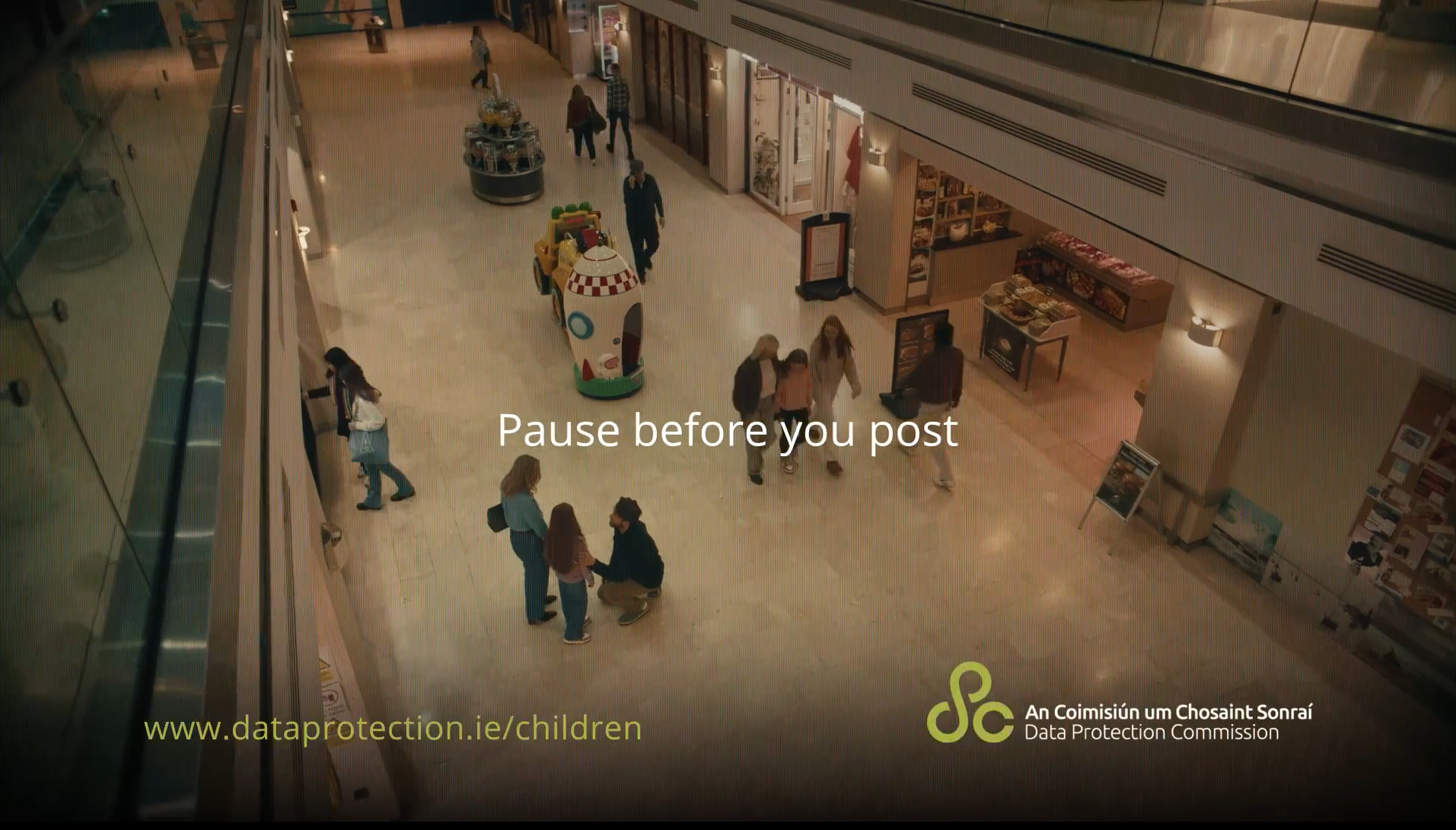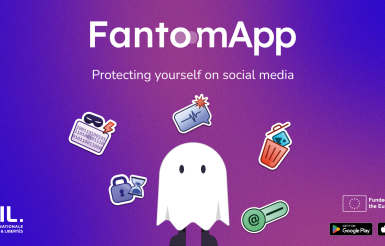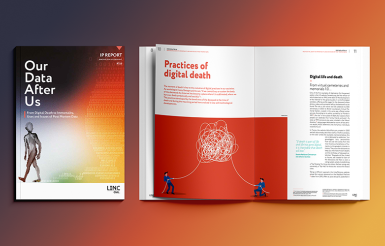Sharing photos and videos of your child on social networks: what risks
28 November 2025
Posting photos and videos of children on social networks (“sharenting”) raises the question of parental responsibility. It has consequences for their children's private lives. What are the risks and what are the best practices to adopt?

of French parents have shared content about their children on social networks.
Source : The French Observatory on parenting and digital education (Observatoire de la parentalité et de l'éducation numérique (OPEN)-POTLOC, 2023)
Sharing videos or photos of your children on social networks is not a harmless act and carries many risks.
Generally speaking, the CNIL strongly advises against sharing photos or videos of your children or grandchildren on social networks, especially when your profile is public. If you still wish to do so, the CNIL suggests practical advice and guidance to follow so as to limit the risks.
About the video ‘Think before you post’ produced with the Data Protection Commission Ireland
What are the risks of publishing your child's image on social networks?
True stories...
The CNIL regularly receives complaints, as herewith showcased:
- A child applied to the CNIL to have photographs, videos and voice recordings posted by his parents on a social network removed.
- Parents drew the CNIL's attention to the difficulties they were experiencing in stopping the dissemination of photographs of their underage children's christenings.
The CNIL assists complainants in obtaining the removal of published images and videos.
The image of your children can be misused for harmful purposes
Videos and photos posted on social networks can be hijacked by ill-intended individuals. Some parents publish nude photos of their children (for example when they are playing in the bath): predators on the Internet hijack these photos to create fake profiles, share them with other strangers or distribute them on child pornography networks.
These ill-intended individuals can retrieve images without needing to be in your contacts, either because your profile is public, or because one of your contacts has shared them publicly or with other "friends".
Moreover, the development of AI systems facilitates the creation of deep-fakes, allowing, for example, to turn photographs of minors published on social networks into nude pictures of them. It consists of images, photographs and videos generated from various children’s content (included dressed), available online on social networks by example. This leads to increasing risks and dangers for children both online and offline.
Indeed, it can:
- Fuel school bullying and cyber-bullying;
- Intensify paedo-criminal practices. On this matter, the “Fondation pour l’enfance” (Foundation for Children) warns in particular about the development of new paedo-criminal contents related to AI use and the multiplication of paedophile content on the dark web, but also throughout publicly accessible web pages.
50%
of children’s photos and videos shared on paedo-criminal forums have been initially published online by their own parents.
Source: Report by the Children's Foundation, Generative AI, the new weapon of paedophile crime, October 2024 (Rapport de la Fondation pour l’enfance, l’IA generative, nouvelle arme de la pédocriminalité, oct. 2024)
Publishing an image can reveal other information about your children
An image taken from a smartphone or camera contains data that can reveal a lot about your child.
Photos and videos often contain information about the location and time at which the image was taken (thanks to the metadata of a photo or video, particularly GPS data). Images can also reveal valuable information about your children - such as their point of interests or the places they frequently attend, - which should not be placed in the hands of an ill-intended individuals.
Creating a digital identity can harm your children in the long term
From a very early age, some children are given a "digital identity" potentially containing hundreds of photos that they will find difficult to delete once they grow up. According to a study conducted by the British agency OPINIUM and published in 2018, the parents of a 13-year-old child have already published an average of 1,300 photos of him or her on social networks.
It is sometimes difficult to measure the extent and the consequences of the footprints left on our children for the future. What poses no problem today may seem unacceptable tomorrow. Always accessible, the photographs and videos shared by parents can prevent their children from their ability to develop their own image and identity. They can damage their online reputation (with the risk of cyber-bullying) and have a negative impact in the school setting, or on their personal and professional future.
What are the best practices to apply?
To ensure that your children are not exposed to the risks associated with "sharenting", the CNIL suggests practical advice and guidance to apply.
Prioritise sharing by instant messaging, email or MMS
Avoid sharing photos and videos of your child on social networks: prefer sharing via secure private instant messaging apps, some of which even have features that allow you to send ephemeral messages. Email or MMS (multimedia messaging service) should also be preferred.
Don't share images of your child with all of your followers on social networks, when you can pass them on to your family and friends privately. Make sure to ask your friends and family not to share photos or videos of your child on social networks without your consent.
Ask your child and the other parent for their consent before any publication.
Before publishing a photo or video of your child on social networks, it's important to talk to him or her and get his or her consent.
You must also seek the consent of the other parent. A number of court rulings have made it clear that publishing photographs of children, particularly on social networks, is a non-routine act that requires the consent of both parents.
Children’s image right, a reinforced right by the law
The French law of February 19th, 2024 has reinforced the protection of children’s image right:
- Parents must ensure that their child’s privacy is respected, including their right to their image. They involve the child in exercising their right to their image, depending on the child’s age and level of maturity.
- If the parents disagree, the judge of family affairs can prohibit one parent from publishing any pictures of their child without the other parent’s consent.
- If a parent’s sharing of their child’s image causes serious harms to the child’s dignity or moral integrity, a compulsory partial delegation of parental authority is instituted.
Avoid sharing certain photos and videos and hide your child's face
If you decide to publish photos and videos of your child, be selective.
Avoid publishing certain photos and videos that involve your child's privacy (for example, a photo of your child in a swimming costume or in the bath).
It is also recommended that you hide your child's face (by taking a photo of your child's back, or adding an emoji to his or her face, etc.) before posting.
Secure your accounts and reduce the visibility of your posts
Lock down your social network accounts by restricting the visibility of your posts to your subscribers to prevent unauthorized people from having access to photos or videos of your children.
For each social network, you can set up privacy settings on your account to limit the visibility of your posts.
On smartphone
- Click on the profile icon at the bottom right of the screen, on the menu at the top right, on "Settings and Privacy" and then on "Privacy".
- You can then set your account to "private account".
- You can also activate the "Profile view history" option. To do so, go back on “Privacy” then select “publication views”
On a computer
- Click on “plus”
- Then press on the settings icon and then of privacy politic.
- You can then set your account on private mode.
- The option “Profile view history” cannot be activated from a computer. To do so, you must go through the mobile app.
Sort through your subscribers and your uploaded photos and videos
Sort out your followers on social networks frequently to avoid being followed by people you don't know.
If possible, classify your subscribers into several categories (close friends, acquaintances, family, etc.): this way you can decide to share your children's photos or videos only with certain groups.
Help and guidance: on Instagram, you can create a group made up of your "close friends", so you don't have to share content about your children with all your followers.
Regularly sort through your photos and videos shared on social networks: this will allow you to delete photos of your child that are no longer topical.
What rights do your children have?
Since 1989 and the International Convention on the Rights of the Child, every minor has had the right to "preserve his or her identity, name and family relations". They must also be protected from "arbitrary or unlawful interference with his or her privacy" and "unlawful attacks on his or her honour and reputation".
The right to an image is a right created by Courts on the basis of the right to privacy under article 9 of the French Civil Code. The children’s image right must be protected by their parents (see as aforementioned).
Children have the right to privacy and the right to their image.
Your children's photos and videos are personal data. Bear in mind that your children under 18 have digital rights over their data. They even benefit from enhanced protection.
In France, it is the parents (or legal representative) who, in principle, exercise the child’s rights, in particular:
- their right of access, which enables them to find out what data an organisation holds about the child;
- its right to rectification, i.e. the right to ask for certain inaccurate, outdated or incomplete information about the child to be corrected;
- its right to erasure, i.e. the possibility to request the deletion of the child's personal data;
- their right to object, for refusing to allow some of the child’s personal data to be used by an organisation for a given purpose.
However, the CNIL believes that children should be able to exercise their own personal data rights on social networks directly. This ability to act autonomously does not override the parents' power to exercise those same rights on behalf of their child and to provide support during the process.
It should be noted that children can also take action against their parents if the latter fail to respect their rights. In 2018, a sixteen-year-old teenager brought a complaint against his mother for violating his privacy. The Rome Court (Italy) ordered the child's mother to stop posting photos of her son on social networks, on pain of a fine.
Deleting photos or videos online
If the photos or videos that you have published of your child on your social networks have been reused without your consent, you can exercise your children's rights on their behalf, in particular their right to deletion. In the same way, your children can request the deletion of photos or videos relating to them without your consent.
The social network will then have to delete the personal data collected as part of its services as quickly as possible.
If no response nor no action is taken, you can:
- contact the police or the appropriate officer if the photo or video puts the child in immediate danger;
- contact 3018 if the photo or video of your child is used for cyberbullying;
- in cases where the social network fails to respond or refuses to take action, submit a complaint to the CNIL within one month of the date of the request, enclosing a copy of the steps taken with the site.
- If the content is illicit (for example, if it is being misused for harmful purposes), report it on the platform Pharos.
Regulations to strengthen children’s protection online
In France, legislators have already strengthened the protection of children online in response to specific issues such as the commercial exploitation of children’s ' images, cyber-bullying and the widespread use of parental controls or even the respect of children’s rights with regard to how their parents use them, as explained on the following website “Vie Publique”.
Thus, the Digital Service Act (DGA), as outlined in the recently published guidelines, imposes new rules that social networks platforms must follow in order to reinforce the online protection of minors.
External resources
- Resources from the Data Protection Commission of Ireland - Back-to-school photos: Keeping information about your child safe - DPC
- 2022 report by the Defender of Rights on "Privacy: a right for children" (in French)
- 2023 study by the Observatoire de la Parentalité et de l'Education numérique, entitled "Parents influenceurs" (in French)
- 2024 report by the Children's Foundation, Generative AI, the new weapon of paedophile crime


